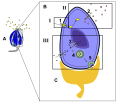Taste receptor
(Redirected from Taste receptors)
Taste receptor refers to a class of G protein-coupled receptors (GPCRs) and ion channels located on the taste buds of the tongue and are responsible for the sensation of taste. These receptors are activated by tastants, which are chemical compounds in foods that can be categorized into five basic tastes: sweet, sour, salty, bitter, and umami. The perception of taste involves the transduction of chemical stimuli into electrical signals, which are then transmitted to the brain for processing.
Types of Taste Receptors
Taste receptors are broadly classified into two types based on their mechanism of action:
Ion Channels
These are directly involved in the detection of salty and sour tastes. Saltiness is primarily detected by the influx of sodium ions through sodium channels, while sourness is detected by the influx of hydrogen ions (H+) which can directly pass through certain ion channels or indirectly lead to the opening of them.
G Protein-Coupled Receptors (GPCRs)
These receptors are involved in detecting sweet, bitter, and umami tastes. They function through a complex signaling pathway that involves the activation of G proteins and results in the perception of these tastes. The GPCRs are further divided into two families:
- T1R - This family includes three types of receptors: T1R1, T1R2, and T1R3. T1R1 and T1R3 combine to form the umami receptor, which responds to amino acids and nucleotides. T1R2 and T1R3 combine to form the receptor responsible for sweetness.
- T2R - This family consists of approximately 30 different receptors that are responsible for the detection of bitter compounds.
Taste Signal Transduction
The process of taste signal transduction involves several steps:
- A tastant binds to its specific taste receptor.
- This binding activates the receptor and initiates a signaling cascade.
- The signaling cascade results in the release of neurotransmitters.
- Neurotransmitters stimulate the sensory neurons associated with taste.
- The electrical signal is transmitted to the brain, where it is interpreted as a specific taste.
Genetic Variation in Taste Perception
Genetic variations can significantly affect the sensitivity of taste receptors, leading to differences in taste perception among individuals. For example, certain genetic variants of the T2R38 receptor are associated with a heightened sensitivity to bitter tastes.
Role in Nutrition and Health
Taste receptors play a crucial role in dietary choices and nutrition by influencing food preferences and intake. They can also impact health by detecting harmful substances, leading to aversive responses to toxic or spoiled foods.
Research and Applications
Understanding the molecular basis of taste perception has implications for the development of artificial sweeteners, flavor enhancers, and strategies to modify food preferences for health benefits. Research in this field also contributes to the understanding of taste disorders and the development of treatments for these conditions.
Transform your life with W8MD's budget GLP-1 injections from $125.
W8MD offers a medical weight loss program to lose weight in Philadelphia. Our physician-supervised medical weight loss provides:
- Most insurances accepted or discounted self-pay rates. We will obtain insurance prior authorizations if needed.
- Generic GLP1 weight loss injections from $125 for the starting dose.
- Also offer prescription weight loss medications including Phentermine, Qsymia, Diethylpropion, Contrave etc.
NYC weight loss doctor appointments
Start your NYC weight loss journey today at our NYC medical weight loss and Philadelphia medical weight loss clinics.
- Call 718-946-5500 to lose weight in NYC or for medical weight loss in Philadelphia 215-676-2334.
- Tags:NYC medical weight loss, Philadelphia lose weight Zepbound NYC, Budget GLP1 weight loss injections, Wegovy Philadelphia, Wegovy NYC, Philadelphia medical weight loss, Brookly weight loss and Wegovy NYC
|
WikiMD's Wellness Encyclopedia |
| Let Food Be Thy Medicine Medicine Thy Food - Hippocrates |
Medical Disclaimer: WikiMD is not a substitute for professional medical advice. The information on WikiMD is provided as an information resource only, may be incorrect, outdated or misleading, and is not to be used or relied on for any diagnostic or treatment purposes. Please consult your health care provider before making any healthcare decisions or for guidance about a specific medical condition. WikiMD expressly disclaims responsibility, and shall have no liability, for any damages, loss, injury, or liability whatsoever suffered as a result of your reliance on the information contained in this site. By visiting this site you agree to the foregoing terms and conditions, which may from time to time be changed or supplemented by WikiMD. If you do not agree to the foregoing terms and conditions, you should not enter or use this site. See full disclaimer.
Credits:Most images are courtesy of Wikimedia commons, and templates, categories Wikipedia, licensed under CC BY SA or similar.
Translate this page: - East Asian
中文,
日本,
한국어,
South Asian
हिन्दी,
தமிழ்,
తెలుగు,
Urdu,
ಕನ್ನಡ,
Southeast Asian
Indonesian,
Vietnamese,
Thai,
မြန်မာဘာသာ,
বাংলা
European
español,
Deutsch,
français,
Greek,
português do Brasil,
polski,
română,
русский,
Nederlands,
norsk,
svenska,
suomi,
Italian
Middle Eastern & African
عربى,
Turkish,
Persian,
Hebrew,
Afrikaans,
isiZulu,
Kiswahili,
Other
Bulgarian,
Hungarian,
Czech,
Swedish,
മലയാളം,
मराठी,
ਪੰਜਾਬੀ,
ગુજરાતી,
Portuguese,
Ukrainian
Contributors: Prab R. Tumpati, MD




